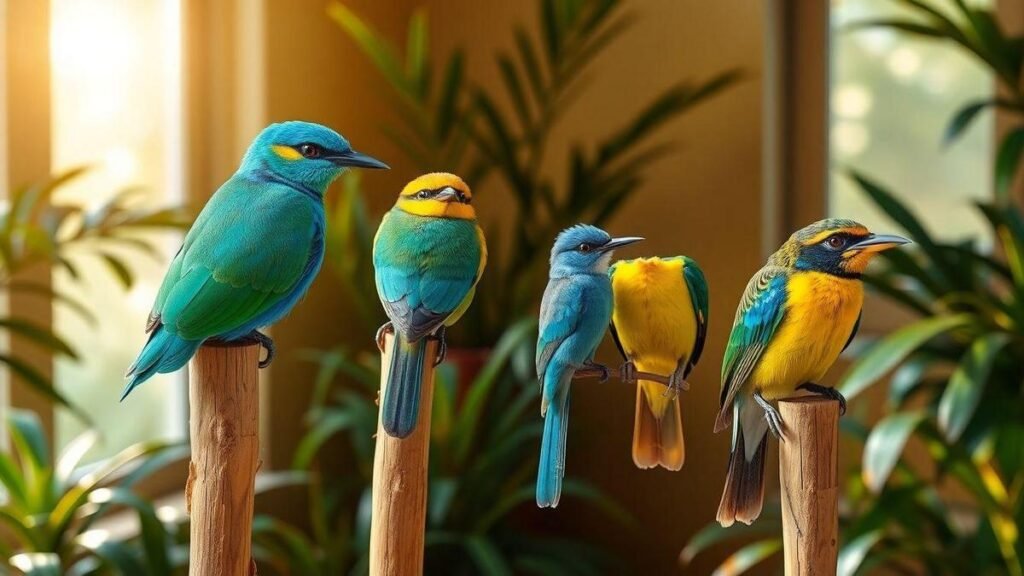Os mais exóticos pássaros de estimação para iniciantes em criação
I know how scary starting can feel. I choose small, hardy birds that are calm and easy to care for. Below I explain how I pick species, set up a safe cage, provide a balanced diet, spot health problems, tame and bond with birds, and plan for costs and legal rules. My tips are simple so you feel confident and excited to bring a bird home.
Key Takeaway
- Pick a bird that fits your time and home.
- Learn the food and vet care your bird needs.
- Make a calm, safe space so your bird feels secure.
- Spend time daily to bond and train gently.
- Plan for noise, long life, and care costs.
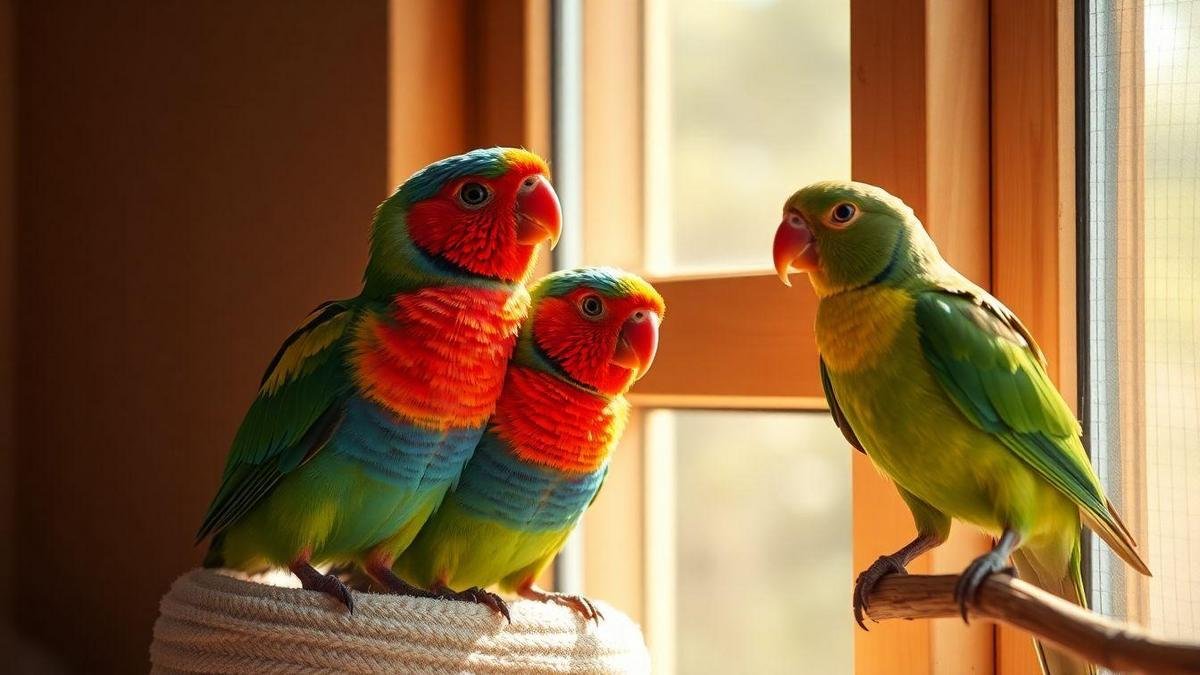
How I choose Os mais exóticos pássaros de estimação para iniciantes em criação
I pick birds with gentle temperaments, clear care needs, and realistic time demands. Think about space, noise, budget, and how much daily handling the bird needs. Ask yourself: can I give this bird a healthy, calm life?
Small, hardy species I recommend (pássaros exóticos para iniciantes, melhores pássaros para iniciantes)
I favor small species that cope well with simple care routines. These are common in rescues and shops and suit beginners.
| Species | Typical size | Noise level | Typical lifespan | Beginner-friendly |
|---|---|---|---|---|
| Budgerigar (Budgie) | Small | Low–Moderate | 5–10 years | Yes — see practical budgie indoor socialization tips |
| Cockatiel | Small–Medium | Moderate | 10–15 years | Yes |
| Zebra Finch | Very small | Low | 5–9 years | Yes |
| Canary | Small | Low (songy) | 8–10 years | Yes |
| Lovebird | Small | Moderate–High | 10–15 years | Yes with social time |
| Parrotlet | Small | Moderate | 10–15 years | Yes if patient |
I bold the parts that matter most: noise, lifespan, and beginner-friendly.
Temperament, noise, and lifespan I look for (espécies de pássaros exóticos fáceis)
I check three things every time: temperament, noise, and lifespan.
- Temperament: a calm or easily socialized bird.
- Noise: manageable noise — singing is fine; constant screaming is not.
- Lifespan: a realistic commitment (e.g., a 10-year bird is a long-term pet).
Quick check: small size, calm temperament, low–moderate noise, simple diet (pellets veggies), known background, and local vet availability. I always ask a seller: “Has this bird shown signs of chronic stress?” To learn how to spot and reduce stress at home, I follow practical guidance on identifying and reducing pet stress indoors.
How I set up home and cages for criação de pássaros exóticos em casa
Reading lists titled “Os mais exóticos pássaros de estimação para iniciantes em criação” reminded me: good setup matters more than fancy gear. Make the cage a safe, predictable center of the bird’s life.
Cage size, placement, and safety tips I follow (guia iniciante pássaros de estimação)
Choose a cage that allows horizontal flight and wing-stretching — bigger is better. When placing the cage, follow general principles for creating a comfortable living area by learning how to create a pet-friendly indoor space.
| Bird size | Example (starter) | Minimum cage dimension (W × D × H) |
|---|---|---|
| Small | Budgies, Finches | 18 × 18 × 18 in (45 × 45 × 45 cm) |
| Medium | Cockatiels, Small Conures | 24 × 24 × 30 in (60 × 60 × 75 cm) |
| Large (beginner avoid) | Amazons, Macaws | 36 × 24 × 48 in (90 × 60 × 120 cm) |
Safety tips:
- Place the cage where you can interact daily, but away from drafts.
- Keep away from kitchen fumes (Teflon is deadly); also follow household-safety tips for chores in shared spaces: keeping pets safe during cleaning and chores.
- Use secure locks to prevent escapes.
- Match bar spacing to bird size to avoid traps.
- Use bird-safe materials (untreated wood, safe paints).
- Avoid mirrors if they trigger aggression.
Perches, toys, and enrichment I use (cuidados com pássaros exóticos)
Mix perches for foot health: natural wood for grip, smooth dowels for variety. Rotate toys to prevent boredom — see steps for introducing new toys and enrichment activities and simple methods for keeping pets mentally stimulated indoors.
What I include:
- Perches: 2–4 sizes/textures.
- Toys: chewing, shredding, and foraging toys; rotate weekly.
- Enrichment: foraging bowls, hidden treats, simple puzzles.
Items I keep on hand:
| Item | Purpose | Tip |
|---|---|---|
| Natural wood perch | Foot exercise | Trim only when loose |
| Rope perch | Play | Replace if frayed |
| Foraging toy | Mental work | Put small veggies inside |
| Small swivel bell | Sound play | Remove if bird fears it |
Daily cage routine:
- Morning: clean food & water bowls; top fresh water, remove uneaten fresh food. See best practices for keeping your pet’s food and water area clean and safe.
- Midday: check toys/perches; give a small foraging treat.
- Evening: spot-clean droppings; dim lights or cover for sleep if needed.

How I feed exotic birds: alimentação de pássaros exóticos basics
I reference “Os mais exóticos pássaros de estimação para iniciantes em criação” often when choosing diets. Start simple: pellets as a base, fresh produce for vitamins, seeds as treats.
Balanced diets and pellets I trust (alimentação de pássaros exóticos, melhores pássaros para iniciantes)
I use pellets for steady nutrition. Typical balance: 60–70% pellets, 20–30% fresh fruits & vegetables, 10% seeds/treats. Add calcium (cuttlebone/mineral block) and fresh water twice daily. For general feeding routines and care, I refer to the broader guide to caring for pets.
| Food type | Why I use it | Quick notes |
|---|---|---|
| Pellets | Balanced nutrition | Main diet for most species |
| Fresh vegetables | Vitamins, hydration | Leafy greens, carrots, bell peppers |
| Fresh fruits | Natural sugars, vitamins | Small portions, no pits |
| Seeds (limited) | Training rewards | High fat; use sparingly |
| Calcium | Bone & egg health | Cuttlebone or supplement |
Safe treats, seeds, and foods to avoid I teach new owners (pássaros exóticos para iniciantes)
Treats are for training, not main food. Good treats: millet spray, small pieces of apple (no seeds), cooked sweet potato, leafy greens. Avoid sugary human snacks.
Foods I never give: avocado, chocolate, caffeine, alcohol, onions, garlic, fruit pits — all toxic or harmful. Remove uneaten fresh food after a few hours.
Safe vs Avoid:
- Safe: millet, spinach, apple (seedless), carrot, peas.
- Avoid: avocado, chocolate, coffee, salty foods, onion/garlic.
Simple feeding schedule:
- Morning: pellets, fresh water, small bowl of vegetables.
- Midday: tiny seed portion or treat during training; check water.
- Evening: remove uneaten fresh food; refill water; offer calcium if needed.
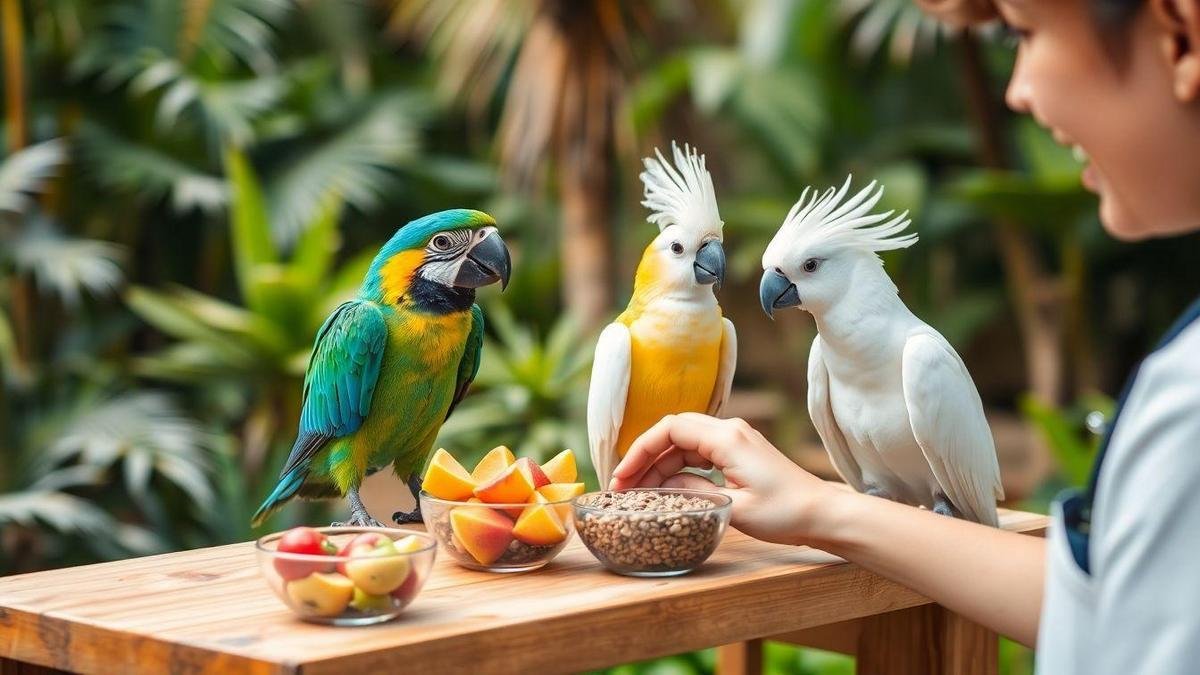
How I keep them healthy: saúde e bem-estar pássaros exóticos
Common illnesses and warning signs I watch for (saúde e bem-estar pássaros exóticos)
Check daily for behavioral and physical changes. Small signs can mean big problems.
| Illness | Common signs | What I do right away |
|---|---|---|
| Respiratory infection | Noisy breathing, tail bobbing, open-mouth breathing | Isolate, quiet warm air, call vet |
| Psittacosis / bacterial | Lethargy, weight loss, green droppings, sneezing | Avoid contact, use gloves, contact vet |
| Feather plucking / skin | Bald patches, constant preening | Check stressors, adjust diet, consult vet |
| Parasitic infection | Itching, visible mites | Clean cage, vet-approved treatment |
| Digestive upset | Vomiting, watery/dark droppings | Stop treats, offer water, call vet if persistent |
Trust your gut: prompt calls to an avian clinic can prevent worsening. If you need help preparing a space to reduce stress and support recovery, see tips on helping pets feel safe and confident indoors.
Finding an avian vet and routine care I recommend (guia iniciante pássaros de estimação)
Look for vets who see birds often. Ask:
- Do you treat birds weekly?
- Can you run fecal and blood tests?
- Do you offer emergency visits?
Routine I follow:
| Routine | Frequency | Notes |
|---|---|---|
| Weight check | Weekly | Record weight; sudden drops matter |
| Vet checkup | Yearly (or sooner) | Fecal checks & full exam |
| Cage cleaning | Daily spot; deep clean weekly | Clean food/water daily |
| Diet review | Weekly | Adjust pellets/veggies as needed |
| Nail/beak check | Monthly | Pro trims preferred |
Clear signs for emergency vet care:
- Not breathing or severe breathing trouble
- Collapsing or lying at cage bottom
- Severe bleeding or broken limb
- Seizures or full-body twitching
- Very dark/bloody droppings with vomiting
- Sudden blindness or unresponsive pupils
Keep your vet’s number on speed dial and know the clinic route. Preparing your bird for alone time and emergency situations is easier if you follow the steps in preparing your pet for indoor alone time.
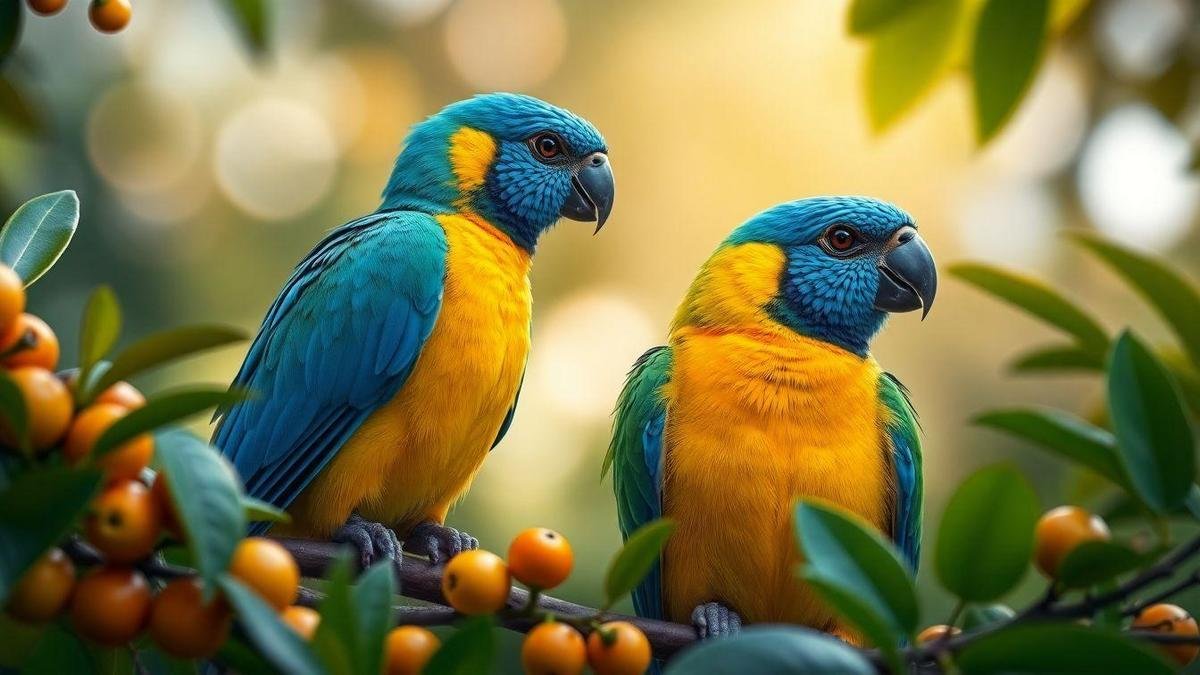
How I train and bond with birds: treinamento de pássaros para iniciantes
Step-by-step taming methods I use (treinamento de pássaros para iniciantes)
Start slow and quiet. Sit near the cage 10–15 minutes daily to build familiarity. Offer a hand with a small treat and wait for the bird to come — never force it. Use a soft name or click as a cue to build association. Keep sessions short. Building a consistent rhythm helps; see how to build a daily routine for your indoor pet.
| Step | Action | Time |
|---|---|---|
| Approach | Sit near cage, speak softly | 10–15 min/day |
| Offer | Hand with small treat | 1–3 min/session |
| Cue | Say name or click, give treat | Repeat 3–5× |
| Move | Slightly extend hand/perch | Daily small gains |
| Repeat | Short sessions, same routine | 5–10 days to progress |
Building trust with simple games and praise I practice (melhores pássaros para iniciantes)
Games like target touch (reward touches to a dowel) and step up (teach stepping onto a finger) build focus and cooperation. Keep sessions under 5 minutes, use clear signals, and reward immediately (within one second). For ideas to keep training fun and enriching, check suggestions for introducing new toys and enrichment activities and other methods for mental stimulation.
Short training session plan:
| Minute | Focus | What I do |
|---|---|---|
| 0–1 | Greeting | Sit calmly, speak softly |
| 1–3 | Warm-up | Offer treat, let bird approach |
| 3–6 | Main drill | Target touch or step up (3–5 repeats) |
| 6–7 | Calm down | Quiet praise, no demands |
| 7–10 | End | Give treat, return bird gently |
Log small wins: date, exercise, and one note.
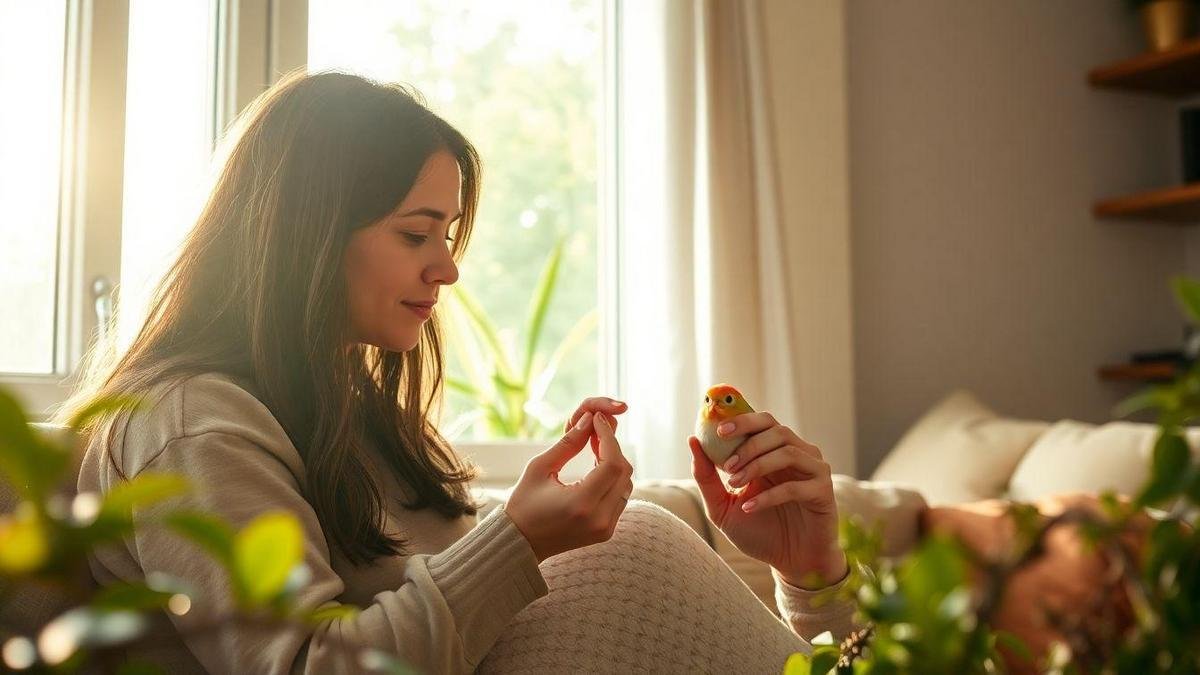
How I handle laws, costs, and long-term care: legislação e licença pássaros exóticos
Permits, local rules and legal checks I do (legislação e licença pássaros exóticos)
Before buying, check local laws and whether the species needs a permit or is protected under CITES. Ask the seller for paperwork and proof of legal origin. Scan and store documents on your phone. If imported, confirm customs and quarantine records. Ask a local avian vet if the species is commonly allowed. When introducing a new bird to an existing household, follow steps for safely introducing a new pet to your home and plan a quarantine period.
Budgeting for food, vet visits and housing I plan (cuidados com pássaros exóticos, criação de pássaros exóticos em casa)
Plan for one-time setup and recurring monthly costs. I consult lists like “Os mais exóticos pássaros de estimação para iniciantes em criação” to match species to my budget.
| Item | Typical one-time cost (USD) | Typical monthly cost (USD) | Notes |
|---|---|---|---|
| Cage & stand | 80–300 | — | Bigger is better; buy sturdy |
| Initial vet exam tests | 60–150 | — | Avian vet for first check |
| Food & supplements | — | 15–50 | Pellets, seeds, fresh produce |
| Toys & enrichment | 20–80 | 5–20 | Rotate to prevent boredom |
| Cleaning supplies | 10–40 | 5–15 | Safe disinfectant & liners |
| Permits / paperwork | 0–200 | — | Depends on species/region |
I build an emergency fund equal to two months of care and budget for occasional vet visits. Shop for a vet you trust before bringing a bird home.
My real-life numbers
My first cockatiel: initial outlay ≈ $220 (cage, food, vet). Monthly ≈ $30. Your numbers may vary by region and species.
Final checklist before bringing a bird home
- Paperwork: permit, bill of sale, health certificate.
- Vet lined up: name, phone, first appointment scheduled.
- Safe cage: correct size, secure locks, proper bar spacing.
- Food & water: species-appropriate pellets, fresh produce, clean water.
- Perches & toys: at least two perch types and a few chew toys.
- Quarantine plan: separate room, 30-day isolation from other birds — follow guidance on helping your pet adjust to a new indoor environment.
- Emergency fund: at least two months of monthly costs set aside.
- Transport carrier: secure and comfortable for the trip.
Conclusion
Taking the first step can feel like jumping into cold water, but it warms up fast. Pick the right species for your life, set up a safe cage, and build a simple routine — these three moves do the heavy lifting. Feed a balanced diet, keep an avian vet on speed dial, and budget for everyday care and surprises. Train slowly; small, steady wins build trust faster than a sprint. Mind the permits and legal checks so paperwork doesn’t trip you up. If you do these things, bonding with your bird becomes like planting a garden that grows with you. For more, read guides and stories at https://blogcraelo.com.
Frequently Asked Questions
Q: What are the best exotic birds for beginners?
A: I recommend budgies, cockatiels, and lovebirds. My guide on Os mais exóticos pássaros de estimação para iniciantes em criação also helps you choose.
Q: How much cage space do they need?
A: Bigger is better — choose a cage that lets them spread wings and fly horizontally. See the cage size table above and tips for creating a safe indoor space in creating a pet-friendly indoor space.
Q: What should I feed a beginner exotic bird?
A: Pellets as the base, fresh fruits & vegetables, limited seeds for treats, and fresh water twice daily. For feeding hygiene, consult keeping food and water areas clean and safe.
Q: Are exotic birds noisy or friendly?
A: Noise varies by species. Some are chatty, some are calm — patience and daily interaction build friendliness. Use short daily sessions and a routine from building a daily routine to improve outcomes.
Q: Where can I learn proper care?
A: Read vet guides, breeder notes, trusted forums, and ask an avian vet when unsure. For general pet-care principles and checklists, see the guide to caring for pets and the blog index at all posts.

